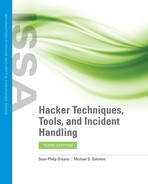0%
131Chapters
0-1Hours read
0kTotal Words
Book Description
Hacker Techniques, Tools, and Incident Handling, Third Edition begins with an examination of the landscape, key terms, and concepts that a security professional needs to know about hackers and computer criminals who break into networks, steal information, and corrupt data. It goes on to review the technical overview of hacking: how attacks target networks and the methodology they follow. The final section studies those methods that are most effective when dealing with hacking attacks, especially in an age of increased reliance on the Web. Written by subject matter experts, with numerous real-world examples, Hacker Techniques, Tools, and Incident Handling, Third Edition provides readers with a clear, comprehensive introduction to the many threats on our Internet environment and security and what can be done to combat them.Book Description
Hacker Techniques, Tools, and Incident Handling, Third Edition begins with an examination of the landscape, key terms, and concepts that a security professional needs to know about hackers and computer criminals who break into networks, steal information, and corrupt data. It goes on to review the technical overview of hacking: how attacks target networks and the methodology they follow. The final section studies those methods that are most effective when dealing with hacking attacks, especially in an age of increased reliance on the Web. Written by subject matter experts, with numerous real-world examples, Hacker Techniques, Tools, and Incident Handling, Third Edition provides readers with a clear, comprehensive introduction to the many threats on our Internet environment and security and what can be done to combat them.Table of Contents
- Cover
- Title Page
- Copyright Page
- Contents
- Preface
- Acknowledgments
- About the Authors
- CHAPTER 1 Hacking: The Next Generation
- CHAPTER 2 TCP/IP Review
- CHAPTER 3 Cryptographic Concepts
- CHAPTER 4 Physical Security
- CHAPTER 5 Footprinting Tools and Techniques
- CHAPTER 6 Port Scanning
- CHAPTER 7 Enumeration and Computer System Hacking
- CHAPTER 8 Wireless Vulnerabilities
- CHAPTER 9 Web and Database Attacks
- CHAPTER 10 Malware
- CHAPTER 11 Sniffers, Session Hijacking, and Denial of Service Attacks
- CHAPTER 12 Linux and Penetration Testing
- CHAPTER 13 Social Engineering
- CHAPTER 14 Incident Response
- CHAPTER 15 Defensive Technologies
- APPENDIX A Answer Key
- APPENDIX B Standard Acronyms
- Glossary of Key Terms
- References
- Index
